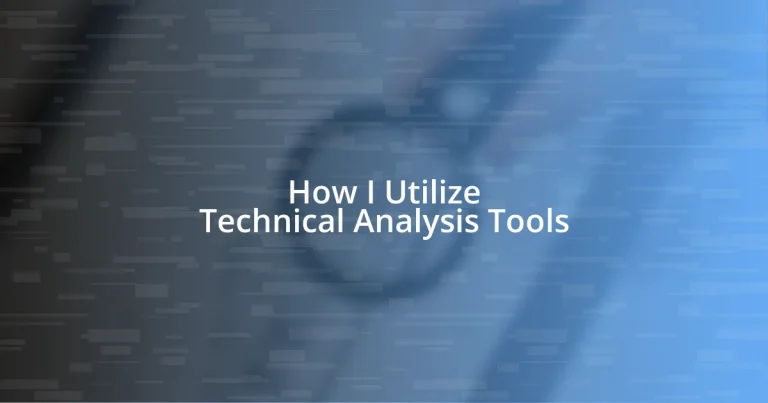Key takeaways:
- Understanding and effectively combining technical analysis tools, such as moving averages and RSI, enhances trading strategy and decision-making.
- Integrating various indicators and continuously evaluating their performance allows for adaptation and refinement of trading strategies over time.
- Personal reflection on both the tools used and emotional state significantly influences trading success, emphasizing the importance of a holistic approach.

Understanding technical analysis tools
When I first dove into the world of technical analysis tools, I was amazed at how these instruments can transform raw price data into insightful trends. I remember feeling overwhelmed by the sheer number of indicators available, from moving averages to the Relative Strength Index (RSI). It’s like having a toolbox full of gadgets; the trick is knowing which one to use at the right moment.
One of the most fascinating aspects of technical analysis is its ability to uncover patterns that are often invisible at first glance. For instance, I vividly recall the thrill of spotting a bullish divergence on a chart—it’s a signal of potential upward movement that, when recognized early, can lead to significant gains. Isn’t it exhilarating to realize that such insights can help predict market behavior?
I often reflect on how my understanding of these tools has evolved over time, especially through hands-on experience. Initially, I leaned heavily on standard indicators, but I later learned the importance of combining different tools for a more comprehensive view. Have you ever experienced the “Aha!” moment after successfully applying a strategy? That rush of excitement is a reminder of why I love using technical analysis in my trading journey.

Types of technical analysis tools
Technical analysis tools come in many varieties, each serving a different purpose to help traders make informed decisions. I still remember my early days of trading when I discovered the efficacy of trend lines. Drawing them felt like illuminating the path ahead, helping me visualize support and resistance levels. Over time, I realized how crucial it is to use a mix of tools to capture different market conditions.
Here’s a quick look at some commonly used technical analysis tools:
- Moving Averages: These smooth out price data to identify trends over specific periods.
- Bollinger Bands: These consist of a middle line (moving average) and upper/lower bands to assess price volatility.
- Relative Strength Index (RSI): A momentum oscillator that indicates overbought or oversold conditions.
- Fibonacci Retracement: This tool helps identify potential reversal levels based on mathematical ratios.
- MACD (Moving Average Convergence Divergence): A trend-following momentum indicator showing the relationship between two moving averages.
I vividly recall how utilizing Fibonacci levels for the first time felt like crackling energy coursing through my veins. Watching the price bounce off those levels reinforced my belief in the strategy’s effectiveness. It’s moments like these that enrich my trading experience, illustrating that the right tools can lead to a deeper understanding of market dynamics.

Setting up technical analysis software
Setting up technical analysis software can be an exciting yet daunting task. I still remember the first time I installed a platform; it felt a bit like preparing for a scientific experiment. I needed to ensure that my settings were optimized for my trading style. After countless hours customizing the chart layouts and selecting my favorite indicators, I finally felt like I was creating a workspace tailored just for me. Have you ever felt that sense of ownership over your tools?
As I navigated through the software, I learned the importance of organizing my workspace. It’s essential to have quick access to tools I rely on most, such as trend lines and moving averages. I spent time exploring the various features, like alert setups and chart time frames. I recall the small rush I felt when I finally figured out how to set alerts for key levels! Not only did it save me time, but it also helped keep my focus sharp during market hours.
Here’s a simple comparison of some popular technical analysis software options:
| Software | Key Features |
|---|---|
| TradingView | Customizable charting, social trading, extensive indicator library |
| MetaTrader 4/5 | Expert advisors, advanced charting, and automated trading capabilities |
| Thinkorswim | Robust options analysis, multiple chart layouts, backtesting tools |
Overall, setting up technical analysis software is not just a technical task; it’s also about creating an environment where I can thrive as a trader. With the right setup, I feel empowered to delve into the charts and uncover the insights hidden within market data.

Interpreting technical indicators effectively
Interpreting technical indicators effectively requires a keen eye and a little patience. I remember the first time I looked at an RSI chart, feeling a mix of excitement and confusion. It took me some time to grasp its significance, but once I did, it became an essential part of my trading toolkit. I would often ask myself, “Is the market truly overbought or oversold?” and using the RSI helped illuminate those moments when the market seemed overhyped or undervalued.
When employing moving averages, I found that combining different durations can reveal deeper insights. For instance, seeing the intersection of the short-term moving average crossing above the long-term average made me feel a rush of possibility. It was like witnessing a green light signaling me to take action. In my experience, it’s not just about spotting these crossovers but understanding the context behind them—what else was happening in the market at that time? This deeper analysis often enhanced my decision-making.
Bollinger Bands taught me a valuable lesson: that volatility is not just noise; it’s a telltale sign of potential price actions. I still distinctly remember a day when the bands tightened dramatically, signaling a breakout was imminent. I could practically feel the market’s energy shift! It made me reflect on how crucial it is to pay attention to not just the indicators but also to the emotions and narratives surrounding them. Have you ever felt that thrill of a potential breakout right before it happens? It’s these moments that remind me that trading is as much about human behavior as it is about the numbers.

Integrating tools into trading strategies
Integrating technical analysis tools into my trading strategies has been a game changer. I remember my first attempt at combining indicators; it felt like piecing together a puzzle. For instance, blending the MACD with stochastic oscillators helped me identify overbought and oversold conditions more accurately. I often ask, “How can I pinpoint the perfect entry and exit points?” Using these tools together offers a clearer picture of market momentum, guiding my decisions with confidence.
One of the key aspects I’ve learned is to adapt my strategies based on different market conditions. There was a time when I relied solely on trend lines, and while they provided direction, they lacked nuance during volatile periods. By adding Fibonacci retracement levels into my strategy, I began to see layers of support and resistance that were often overlooked. Have you ever noticed how a simple adjustment can unlock new levels of understanding? The thrill of discovering these combinations fuels my passion for trading every single day.
Tailoring my approach has involved constant experimentation. When I first experimented with integrated toolsets, I felt like a chef trying out ingredients for the first time. Mixing Elliott Wave theory with candlestick patterns revealed price movement behaviors that I hadn’t noticed previously. It’s an exhilarating process. Ultimately, I’ve come to realize that the integration of these tools is a dynamic journey—what works one day may evolve into something new the next. Isn’t that the beauty of trading? There’s always more to learn and adapt to.

Evaluating tool performance over time
Evaluating tool performance over time has been essential in refining my trading strategies. I often take a step back to analyze my success rates with various indicators, allowing me to see patterns in my use of tools. For instance, after a month of trading, I noticed that my reliance on Bollinger Bands yielded consistent wins during breakout scenarios, while other periods seemed to falter. Isn’t it fascinating how reflecting on past experiences can illuminate the effectiveness of our choices?
One particular trading period stands out in my mind when I closely examined the performance of my moving averages over three months. Initially, I felt a sense of frustration as there were times I was caught in false signals. It made me wonder if I was relying too heavily on this approach. However, by isolating those instances and analyzing the broader market trends, I discovered that my moving averages performed best during steady, trending markets, which shifted my perspective. Have you ever had that enlightening moment where dissecting your past actions leads you to a new strategy?
I’ve also found value in tracking my performance metrics, such as win-loss ratios and average trade duration. In doing so, I’ve noticed how my emotional state can influence these numbers. There was a phase where external distractions led to impulsive decisions, resulting in what I call a “trading slump.” Recognizing this pattern was crucial; it taught me that my environment affects my tool’s performance just as much as the tools themselves. How often do we overlook the human element in our analyses? Balancing technical data with personal insights forms a richer understanding of what truly drives success in trading.














